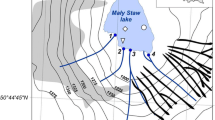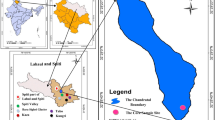Abstract
Land-use and climate changes are the most environmental issues in the Hircanian Forest, Northern Iran. Valasht Lake is a mountainous basin desirable for studying sedimentation rates as off-site impacts of environmental changes. The research objective was to quantify the historical trend of sedimentation rate in response to anthropogenic and climate factors influencing the catchment of Valasht Lake. The sediment chronology performed using fallout radioisotopes (226Ra, 137Cs, and 210Pb) and the Constant Rate of Supply Model. The off-site impacts of the whole complies of land use changes including deforestation and climate change resulted in sediment flux into the Valasht Lake with a mean rate of 0.94 kg m−2 y−1, since 1864. The studied sediment profile shows three different sedimentation periods manifested by three specific sediment layers with a mean sedimentation rate of 0.25 ± 0.05 (1984–1964), 0.76 ± 0.17 (1964–2006), and 2.28 ± 0.7 (after 2006) kg m−2 yr−1. During the forming of layers, the annual sediment yield has been 50, 152, and 456 tonnes, which infers land degradation and an increase in flash flood frequency. The 210Pb dating method revealed extreme events of sediment deliveries, especially in 1963, 1983, 2002, 2007, and 2011–2019 years. Organic-rich mud deposits (TOC, 17.9 ± 4%) accumulated during the last period since 2006. It can be attributed to the increasing trend of burning the forest clear-cuts and ash flux into the lake. Integrated watershed management practices and desirable land-use planning are recommended to preserve the natural resources of Valasht Lake and its catchment.




Similar content being viewed by others
References
Abdinejad P, Phaznia S, Peiravan HR (2021) Classification of marly rock units of Zanjan province based on physicochemical characteristics and cluster analysis. Earth Knowl Res 48:1–18 (In Farsi)
Amani M (2003) Study of forest cover typology of Velesht Lake catchment. Forest and Rangel 59:40–46 (In Farsi)
Appleby PG (2000) Radiometric dating of sediment records in European mountain lakes. Limnol 59:1–14
Appleby PG, Oldfield F (1978) The calculation of lead-210 dates assuming a constant rate of supply of unsupported 210Pb to the sediment. CATENA 5:1–8
Appleby PG, Oldfield F (1983) The Assessment of Pb-210 data from sites with varying sediment accumulation rates. Hydrobiologia 103:29–35
Appleby PG, Richardson N, Nolan PJ (1991) Am 241 dating of lake sediments. Hydrobiologia 214:35–42
Begy R, Cosma C, Horvath Z (2009) Sediment accumulation rate in the Red Lake (Romania) determined by Pb-210 and Cs-137 radioisotopes. Earth Env Phys 54:943–949
Berberian M (2014) Chapter 11 - Pre-1900 coseismic surface faulting. In: Berberian M (ed) Developments in earth surface processes. Elsevier, Germany, pp 183–238
Blott SJ, Pye K (2001) GRADISTAT: A Grain Size Distribution and Statistics Package for the Analysis of Unconsolidated Sediments. Earth Surf Process Landform 26:1237–1248. https://doi.org/10.1002/esp.261
Bobek H (2005) Historical view of natural forests and Iran’s trees. Geog Org Armed Forces, Tehran
Cohen AS (2003) Paleolimnology: the history and evolution of lake systems. Oxford University Press, New York
Diwate P, Meena NK, Bhushan R, Pandita S, Chandana R, Kumar P (2020) Sedimentation rate (Pb-210 and Cs-137), grain size, organic matter and bathymetric studies in Renuka Lake, Himachal Pradesh, India. Himalayan Geol 41:51–62
Ehteshami-Moinabadi M, Nasiri S (2019) Geometrical and structural setting of landslide dams of the Central Alborz: a link between earthquakes and landslide damming. Bull Eng Geol Env 78:69–88
Einax JW, Zwanziger HW, Geib S (2007) Chemometrics in environmental analysis. Wiley-VCH, Weinheim, Germany
Field JP, Farrish KW, Carter EA (2000) Soil and nutrient loss following site preparation burning. Scientific Journal (JRNL). Midwest Express Center, Milwaukee, Wisconsin
Gharibreza M, Ashraf MA (2014) Applied limnology: comprehensive view from watershed to lake. Springer, Japan
Gharibreza M, Raj JK, Yusoff I, Othman Z, Wan-Zakaria WT, Ashraf MA (2013a) Sedimentation rate in Bera lake and soil redistribution at its catchment using radioisotopes. Geosci J 17:211–220
Gharibreza M, Raj JK, Yusoff I, Ashraf MA, Othman Z, Wan-Zakaria WT (2013b) Effects of agricultural projects on nutrient levels in Lake Bera (Tasek Bera), Peninsular Malaysia. Agri Ecos Env 165:19–27
Gharibreza M, Raj JK, Yusoff I, Ashraf MA, Othman Z, Wan-Zakaria WT (2013c) Land use changes and soil redistribution estimation using 137Cs in the tropical Bera Lake catchment, Malaysia. Soil till Res 131:1–10
Gharibreza M, Zaman M, Porto P, Fulajtar E, Parsaei L, Eisaei H (2020) Assessment of deforestation impact on soil erosion in loess formation using 137Cs method (case study: Golestan Province, Iran). Int Soil Water Cons Res 8:393–405
Gharibreza M, Bahrami SA, Arabkhedri M, Zaman M, Porto P, Kamali K, Sobh-Zahedi Sh (2021) Investigation of on-site implications of tea plantations on soil erosion in Iran using 137Cs method and RUSLE. Environ Earth Sci 80:2–14. https://doi.org/10.1007/s12665-020-09347-y
Gharibreza M, Zaman M, Arabkhedri M, Sobhezahedi Sh (2022) The off-site implications of deforestation on sedimentation rates and pollution in Abkenar open water (Anzali Lagoon, Caspian Sea) using radionuclide techniques and sediment quality indices. Int J Sed Res 37:370–382
Goldberg ED (1963) Geochronology with Pb-210. In: IAEA (ed), Symposium on Radioactive Dating. International Atomic Energy Agency, Vienna, Austria, pp 121–131
IAEA (1983) Radioisotopes in Sediment Studies. IAEA-TECDOC-298. International Atomic Energy Agency, Vienna
IAEA (1995) Use of nuclear techniques in studying soil erosion and siltation. TECDOC-828. International Atomic Energy Agency, Vienna
IAEA (2005) Fluvial sediment transport:Analytical techniques for measuring sediment load. IAEA-TECDOC-1461. International Atomic Energy Agency, Vienna
Khodadadi M, Alewell C, Mirzaei M, Ehssan-Malahat E, Asadzadeh F, Strauss P, Meusburger K (2021) Deforestation effects on soil erosion rates and soil physicochemical properties in Iran: a case study of using fallout radionuclides in a Chernobyl contaminated area. Soil Discuss 2021:1–41. https://doi.org/10.5194/soil-2021-2
Krishnaswami S, Lal D, Martin JM, Meybeck M (1971) Geochronology of lake sediments. Earth Planet Sci Lett 11:407–414
Jackson IJ (1972) Mean daily rainfall intensity and number of rain days over Tanzania. Geografiska Annaler Ser a, Phys Geog 54:369–375
Last WM, Smol JP (2001) Tracking environmental change using lake sediments. Kluwer Academic Publishers New York, Boston, Dordrecht, London, Moscow
Mahmoudzadeh A (1997) Relations between sediment yield and land-use pattern. J for Rang 36:22–36
Malmer A (1990) Stream suspended load after clear-felling and different foresty treatment in tropical rainforest, Sabah, Malaysia. Int Ass Hydrol Sci Pub 192:62–71
Nandargi S, Mulye SS (2012) Relationships between rainy days, mean daily intensity, and seasonal rainfall over the Koyna catchment during 1961–2005. Sci Wor J 2012:894313
Nazari H, Ritz JF, Salamati R, Shafei A, Ghassemi A, Michelot JL, Massault M, Ghorashi M (2009) Morphological and palaeoseismological analysis along the Taleghan fault (Central Alborz, Iran). Geophy J Int 178:1028–1041
Nearing M, Pruski FF, O’Neal MR (2004) Expected climate change impacts on soil erosion rates: a review. J Soil Water Conserv 59:43–50
O’Sullivan PE, Reynolds CS (2005) Lake Restoration and Rehabilitation, vol 2. Blackwell Publishing, Oxford, UK
Pennington W, Tutin TG, Cambray RS, Fisher EM (1973) Observations on lake sediments using fallout 137Cs as a tracer. Nature 242:324–326
Perry C, Taylor K (2007) Environmental sedimentology, vol 1. Blackwell Publishing, Oxford, UK
Raja RKP, Reddy S (2019) Regression analysis between mean daily intensity, rainy days and seasonal rainfall in normal, excess and deficient years: a case study. Mausam 70:141–158
Rai SP, Kumar V, Kumar B (2007) Sedimentation rate and pattern of a Himalayan foothill lake using 137Cs and 210Pb. Hydrol Sci J 52(1):181–191. https://doi.org/10.1623/hysj.52.1.181
Robbins JA, Edgington DN, Kemp ALW (1978) Comparative 210Pb, 137Cs, and pollen geochronologies of sediments from Lakes Ontario and Erie. Quat Res 10:256–278
Routschek A, Schmidt J, Kreienkamp F (2014) Impact of climate change on soil erosion—a high-resolution projection on catchment scale until 2100 in Saxony/Germany. CATENA 121:99–109. https://doi.org/10.1016/j.catena.2014.04.019
Sadatnia and Ahzan (2007) Determining the amount of erosion and erosion index of Damavand watershed formations by the sedimentological method. In: 3rd conferences on applied geology and environment. Azad University, Islamshahr branch, pp 452–476
Safaei M, Shoaei Z, Jafari S (1997) The evaluation of potential of instability risk and break landslide dam Valasht, Mazandaran Province. Soil Conservation and Watershed Management Research Institute, Tehran, 135 (In Farsi)
Seyed-Alipour H, Feiznia S, Ahmadi H, Zare M, Hosseinalizadeh M (2014) Comparison of soil erosion by 137CS and RUSLE-3D for loess deposits North-East of Iran (study area: Aghemam catchment). J Water Soil Conserv 21:27–47
Singh CV (1998) Relationships between rainy days, mean daily intensity and seasonal rainfall in normal, flood and drought years over india. Adv Atmos Sci 15:424–432
Szarlowicz K, Reczynski W, Czajka A, Spyt B, Szacilowski G (2018) Comprehensive study of the mountainous lake sediments in relation to natural and anthropogenic processes and time (Mały Staw Lake, Poland). Env Sci Poll Res 25:3335–3347
Vahidi F, Mousavi-Nodushan R, Fatemi SM, Jamili S, Kham Khaji N (2016) Investigation of Valasht Lake trophic state based on TSI Index. J Env Sci Tech 18:445–453
Walkley AI, Black A (1934) An examination of the Degtjareff method for determining organic carbon in soils: effect of variations in digestion conditions and of inorganic soil constituents. Soil Sci 63:251–263
Acknowledgements
We thank the International Atomic Energy Agency (IAEA) Vienna for technical and financial support under the national TC project (IRA5013), the Soil Conservation and Watershed Management Research Institute of Iran (SCWMRI), Nuclear Science & Technology Research Institute (NSTRI), Atomic energy organization of Iran, and National Liaises Office (NLO) for technical cooperation with the IAEA.
Funding
This work was supported by International Atomic Energy Agency (Grant number IRA5013).
Author information
Authors and Affiliations
Corresponding author
Ethics declarations
Conflict of Interest
The authors’ declare that they have no conflict of interest.
Additional information
Publisher's Note
Springer Nature remains neutral with regard to jurisdictional claims in published maps and institutional affiliations.
Rights and permissions
About this article
Cite this article
Gharibreza, M., Zaman, M., Mahmoudi, M. et al. Assessing the impact of land use and climate changes on the sedimentary regime of Valasht mountainous Lake (Iran) using radionuclide techniques. Environ Earth Sci 81, 357 (2022). https://doi.org/10.1007/s12665-022-10484-9
Received:
Accepted:
Published:
DOI: https://doi.org/10.1007/s12665-022-10484-9




